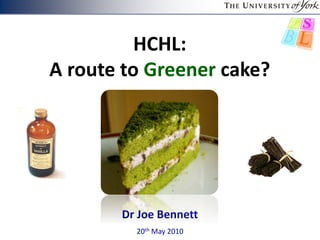J Bennett PhD presentation
- 1. HCHL: A route to Greener cake? Dr Joe Bennett 20th May 2010
- 2. INTRODUCTION
- 3. Natural vanilla extract • Over 180 compounds  Principle component – vanillin (~85%) • Vanilla orchid – pods and beans Flavour Fragrance Pharmaceuticals INTRODUCTION Vanilla
- 4. Natural v Synthetic • 12,000 tons per year  0.5% - natural vanilla  >99% - synthetic $1200 - 4000 kg-1 ~$15 kg-1 1Hocking, M. (1997) J. Chem. Educ. 74, 1055-1059 1 INTRODUCTION Vanillin production
- 5. Ferulic acid metabolism • Pseudomonas fluorescens  Ferulic acid – sole carbon source2 • Ligation to coenzyme A  Ligase HCLS Hydroxycinnamoyl CoA Hydratase Lyase – HCHL Hydration / ligation P. fluorescens biofilm 2Narbad, A. et al (1998) Microbiology. 144, 1397-1405 INTRODUCTION HCHL
- 6. Additional substrates3 3Mitra, A. et al (1999) Arch. Biochem. Biophys. 365, 10-16 INTRODUCTION HCHL
- 7. - Crotonases INTRODUCTION Crotonase superfamily • Structurally related proteins4 ECH PVIAAVNGYALGGGCELAMMCDIIYAGEKAQFGQPEILLGTIPGA 173 HCHL PTIAMVNGWCFGGGFSPLVACDLAICADEATFGLSEINWGIPPGN 152 *.** ***:.:*** . : **: ..::* ** .** * ** Oxyanion hole conserved ‘Catalytic’ Glu conserved ‘Catalytic’ Glu NOT conserved 4Bennett, J. et al (2007) Biochemistry. 46, 137-144 5Engel, C. et al (1998) J. Mol. Biol. 275, 847-859 • Parent – Enoyl CoA Hydratase (ECH)5
- 8. 6Leonard, P. et al (2006) Acta. Cryst D. 60, 2343-2345 Tyr239 2.7 INTRODUCTION HCHL model Structure modelling • Native HCHL structure6  Ligand-bound ECH structure  Feruloyl CoA Glu-143: Water activation? Ser-123: Lytic function? Tyr-239: Substrate binding?
- 9. RESEARCH
- 10. RESEARCH Experiments performed • HCHL variants  Cloning, transformation, expression, purification Project outline Wild Type S123A E143A S123A/E143A Y239F Y239A Michaelis-Menten kinetics X-ray Crystallography Organic synthesis [Substrate] 0 0.02 0.04 0.06 0.08 Rate 0 2 4 Parameter Value Std. Error Enzyme Kinetics Data MECHANISM
- 11. 7Bennett, J. et al (2008) Biochem. J. 414. 281-289 RESEARCH UV/Vis kinetics Michaelis-Menten kinetics7 • Feruloyl CoA depletion – 400 nm
- 12. RESEARCH Structural studies Apo and holo-HCHL • Native wild type HCHL • No ligand • Wild type HCHL  Co-crystallised with feroloyl CoA • Observations  Vanillin  Loop shift on ligand binding  Second Tyr moves ~6 Å
- 13. RESEARCH Structural studies Density maps Glu-143: H-bonded to product Tyr-239: H-bonded to product Tyr-75: H-bonded to product
- 14. DISCUSSION
- 15. 8Fraaije, M. et al (1998) Eur. J. Biochem. 253, 712-719 DISCUSSION Examining mechanism Vanillyl Alcohol Oxidase (VAO)8 Green: VAO Blue: HCHL Similar substrate O2+ Tyrosine pincer
- 16. VAO mechanism – 4-(methoxymethyl) phenol9 9van den Heuvel, M. et al (2000) J. Biol. Chem. 275, 14799-14808 Quinone methide Intermediate DISCUSSION Vanillyl alcohol oxidase
- 18. • Substrate specificity: Tyr-75 and Tyr-239 SUMMARY HCHL Glu-143: Essential for activity • Similarities to VAO – not obvious from apo-enzyme • Quinone methide - possible intermediate Ser-123: No major role in catalysis
- 19. ACKNOWLEDGEMENTS Gideon Grogan Marek Brzozowski Johan Turkenburg YSBL staff BBSRC










![RESEARCH
Experiments performed
• HCHL variants
 Cloning, transformation, expression, purification
Project outline
Wild
Type
S123A E143A S123A/E143A
Y239F Y239A
Michaelis-Menten
kinetics
X-ray Crystallography
Organic synthesis
[Substrate]
0 0.02 0.04 0.06 0.08
Rate
0
2
4
Parameter Value Std. Error
Enzyme Kinetics Data
MECHANISM](https://image.slidesharecdn.com/fc8fe207-dc2f-45c4-a629-c643658e7f5b-150311100005-conversion-gate01/85/J-Bennett-PhD-presentation-10-320.jpg)








